Do you often experience swollen feet and ankles? Do your extremities get painful, itchy, and sore? If yes, then you are not alone. Swollen feet and ankles is a prevalent condition among men and women of all ages.
Although this is not much of a danger to your health, they can cause extreme discomfort and prevent you from moving, traveling, and get on with your day to day tasks.
Prolonged swelling might itself be a symptom of some other underlying health issues. If you experience severe chronic swelling of the feet or a sprain – then you might be suffering from edema.
Related: Edema Compression Socks, What Level of Compression Socks Do I Need, Men’s Compression Socks
You should visit your physician for appropriate medical guidance and treatment.
Common Symptoms of Swollen Feet
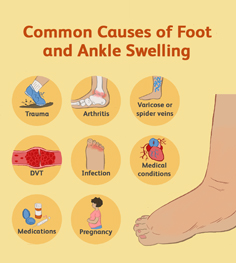
Before going into the causes of this condition, let us first discuss the usual signs and symptoms of swollen feet.
The first noticeable change that you might experience is the puffiness in your toes and feet. With in the early two or three hours the enlargement, the skin becomes noticeable, and you can feel the tenderness or mild throbbing in your feet. You may also feel heaviness in the lower body and fluids starting to fill your feet like a sack.
By the fourth hour, the size of the feet and ankle will have increased and can be noticeable. Your footwear (shoes, sandals, or slippers, etc.) might suddenly feel cramped and of a smaller size. The majority says that they might also experience slightly darker (visible) indentations when they remove their shoes and socks.
Another test that can prove your doubts real is the finger test. If you press on the swollen area with your finger and experience some indentation with the skin returning to its puffy state, when you remove the pressure, then it is indeed a case of swelling. Most people experience this during a sprain.
Most Common Causes
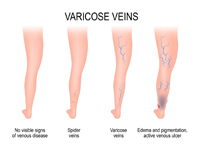
Several factors can contribute to swollen ankles, including trauma, edema, varicose veins, hypertension, prolonged sitting or standing, blood circulatory issue, and pregnancy. Most of the patients suffer from swollen ankles at the same time when their feet are swollen.
Most of the causes of swollen feet are also responsible for swelling of ankles such as a sprain. Some of the significant reasons for swollen feet are:
Pregnancy
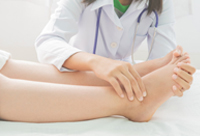
For pregnant women, this can be a frustrating affair. This swelling of feet and ankles usually gets more and more in the later stages of pregnancy. As the uterus of the expecting mother grows, the pressure and excess body fluids start to accumulate in the feet and cause swelling or edema.
Edema or Oedema
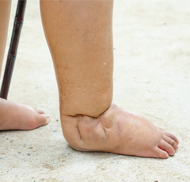
Peripheral or ankle edema is the swelling of feet and ankle, respectively, due to extended periods of standing or walking. This condition is also known as dependent swelling and mostly happens with pregnant women.
Trauma

Injury is one of the leading causes. A wound to the foot, ankle, or leg can lead to swelling of the foot or ankle. If the swelling is not bilateral (not on both feet), there is a fair chance that this is due to any trauma to the body.
Lymphatic system disorder
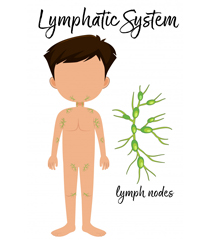
Humans carry a lymphatic system as a part of the immune system to fight against disease and external harmful agents that somehow manage to enter the body. The system consists of lymph nodes vessels that carry a clear fluid. A blockage in this system can cause an accumulation of lymph fluid and can cause swelling of the feet and ankles as well. There can be many reasons for blockage or malfunctioning of this system, like infection or injury to the lymph vessels.
Side effects of medication

Many drugs can become a cause as a side effect. These side effects can vary from person to person and depend on your specific conditions. Anti-inflammatory, anti-depressant, and cardiovascular medicines can cause side effect in many people.
Angioedema

Skin allergy can also cause a condition similar to what is called angioedema. Being reffered to as ‘giant hives,’ the swelling is in the inner part of the skin surface caused by an allergic reaction to food, medicine, environmental conditions (exposure to pollen or latex), and sometimes from bug bites (spider or insects).
How to Relieve the Pain?
Treatments for Swelling:

If the swelling is chronic, you should schedule an appointment with a doctor in any legitimate medical centers such as the cleveland clinic and listen to what he says. He will take your history, assess your condition, and might suggest some lab tests as well to diagnose the possible reason for the swelling. If the condition is an allergic reaction or a side effect of medicine, he will point to that. If there is an injury or some issue with lymphatic vessels, he will suggest alternate treatment or medication.
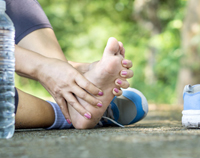
Take note of what the doctor says during the appointment, as he/she might ask you to use the following home remedies and best practices to mitigate the swelling:
Compression socks
The easiest and one of the most effective treatments for swollen feet and ankles is the use of compression socks. These stockings apply a certain amount of pressure to your feet and prevent fluid accumulation in your feet. (This is the opposite of loose fitting socks for swollen ankles.)
Keep in mind that you can find compression socks for swollen feet and legs. There are wide calf compression socks if your legs are larger than normal.
Elevation of lower body
A temporary but effective way to overcome puffed up feet is to elevate the lower part of your body above the heart rate. You can do this by lying down and raising your legs for a while. This will allow the fluids accumulated in your feet to return towards the core of your body. Since your legs will be at a higher level, your heart will have to work against gravity to pump blood towards them. This will restrict fluid movement towards your feet.
Exercise
Regular physical activity and exercise such as yoga, are great as it keeps you in shape, flex your body muscles, and stretch your limbs. The movements during yoga or any other exercise cause your heart to pump harder and improve the fluid circulation through feet. Individuals with edema can ask for specific exercise for their legs and feet to improve their condition.
Soaking in Epsom Salt
Epsom salt has magnesium sulfate in it and mostly used to improve the circulation of the affected part. You have to soak your ankles and feet in cold or warm water with some Epsom salt.
Increase Magnesium and Potassium in your diet

Magnesium deficiency is also sometimes associated with swollen feet. You can add up to 400 mg of magnesium to your daily diet to cater to this deficiency. Its best to eat magnesium-rich fruits, vegetables, and nuts, but you can also have magnesium supplements after consulting your doctor.

Similarly, potassium deficiency can cause high blood pressure and fluid retention.
Small Changes in Your Lifestyle:
Some small daily life changes can reduce the pain and tenderness of your feet. These include:
- It can be surprising for you, but drinking more water and keeping yourself hydrated can relieve some pain.
- Take short breaks from long sitting or standing day jobs and try to stretch and flex your limbs. If you can allocate a day in a week – you may try doing yoga.
- Try to elevate your legs. At home, when you are lying on a couch or in your bed.
- Elevation of your legs with the use of your mattress or bed base in a way that makes your feet at a slightly higher level.
- Avoid alcohol, and if you are a smoker, try to reduce this habit too.
What Are Compression Socks?

Compression stockings are different from regular socks you wear for daily use with your shoes. These are specially designed socks that squeeze your feet and ankles gently. Compression socks are also known as Compression Stockings.

Compression sleeves are also used to reduce feet and ankle swelling. Sleeves are slightly different than the socks as they lack the foot portion and only cover the shin and the calf area. However, both socks and sleeves can run as high as the knee or even thigh. Compression sleeves are also known as knee sleeves.

Compression socks for swollen feet are stretchy and come in snug-fitting design. They are graduated and apply more pressure to your ankles and feet and then gradually reduce this pressure towards the knees.
Compression socks have a variety of compression levels, starting from 5 to 8 mmHg to, medium 20-30 up to 40 mm Hg. You can also find them in a variety of sizes, materials, and colors, as well. It’s always best to do your research in order to find what is right for you.
Most of the patients prefer the use of 20 – 30 mmHg pressure socks for their daily purpose. You can choose the size, material, color, and level according to your taste and preference.
Compression Socks are so common in the medical field that there are even compression socks for nurses who stand all day. If you’re older and looking to improve your leg health too, look for the best compression socks for elderly men and women.
How Can Compression Socks for Swelling Relieve the Pain?

Compression socks are highly effective in treating and stop the progression of edema, venitis, thrombosis, blood clotting, varicose veins, illnesses in the vascular system and reducing swelling of feet, ankles, and legs. Physicians recommend these socks and sleeves for mild swelling as well as chronic edema patients.
The durable elastic material is used to making compression stockings. That applies a calculated amount of continuous pressure to your limbs.
This pressure reduces the diameter of your surface of the vascular system – such as the veins and increases the blood flow through them. The applied pressure on the limb, especially the calf muscle, prevents fluid build-up -such as venous insufficiency and eases the flow of blood back to the heart, making you feel lighter and less swollen.
Another benefit of wearing them is the reduced risk of clot formation in your veins. As the blood circulation improves, it becomes difficult for blood to remain stagnant and pool in the blood vessels leading to blood clotting.
To find the stockings that work best for you – you have to carefully choose your size, and the socks fit properly.
Ideally, Mostly people prefer, and the physician says that they would recommend the use of knee-high 20-30mmHG Compression Socks. You can see the Compression socks chart below to get a better idea.
Wearing your Compression Socks for Swelling
These socks and sleeves can be worn daily at home or at work. You can wear them while walking, sitting, and during your everyday errands. This is usually taken off during the night for sleep. You can put them back on again in the morning before leaving for work, just like ordinary socks.
When you are wearing socks, they should smoothly conform to your body. When you are putting them on, make sure to remove any wrinkles and folds.

Here are some of the actions you might want to take care of when wearing them:
- Do not fold the socks from the top or the bottom.
- By putting them on with Vaseline or similar product, they can damage the sock material. Please do avoid and do not use these when wearing them.
- Do not try to tug the sock from edges when putting them on, instead roll it smoothly.
- Make sure there is a space equal to the width of two fingers below the knee and groin line and the top of the sock (depending on the type of hose you are wearing knee-high or thigh-high)

Some athletes also use sleeves on their limbs to increase oxygen-rich blood flow to their muscles and prevent the risk of cramps and tissue injury.
If your condition is unilateral (swelling in one foot or leg), you can buy a single pair. If you wear them on both, you can buy two pairs, so if you need to wash a pair, you have another one for backup.
You should take care while washing them. Please hand-washed them and let them dry at room temperature, away from direct sunlight. Compression socks can usually last up to six months.
The Bottom Line

Compression socks are an effective way to reduce swollen feet. Not only that they look cool, but they are also a comfortable solution to your achy feet and puffy ankles. If you take appropriate care and follow the instructions while wearing and removing them, you can make your day a lot better by their regular use.
This page last updated December 10, 2022
